Researchers from Oxford University have engineered novel antibiotic-loaded nanoparticles to combat biofilms, a significant factor in antimicrobial resistance. These biofilms, secreted by bacteria, form a protective environment, increasing their resistance to treatment and posing a challenge in treating chronic infections.
The development comes from a collaboration between Oxford's Department of Engineering Science and the Nuffield Department of Orthopaedics, Rheumatology, and Musculoskeletal Sciences. The nanoparticles, when activated by ultrasound, disrupt biofilms and release antibiotics directly to the infection site. This ultrasound technique provides a targeted, non-invasive method to combat infections within the body.
Professor Eleanor Stride, the Principal Investigator of the project, emphasized the innovation's potential impact: “Innovative solutions are desperately needed to extend the action of life-saving antibiotics. Our findings are very promising, as treatment of chronic infections associated with biofilm production continues to be a challenge in the face of spreading antimicrobial resistance worldwide. The methods we used in this study were designed with clinical use in mind, and we look forward to developing this system further for application in healthcare settings.”
The team tested the nanoparticles on ten clinical bacterial strains, including E. coli and MRSA, with various antibiotics. For bacteria not forming biofilms, the method reduced the necessary antibiotic concentration more than tenfold compared to conventional treatments. More impressively, in biofilm-related infections, the technique cut the required antibiotic concentration by over 40-fold, successfully eliminating all bacteria at feasible doses.
The nanoparticle system also showed high effectiveness against persister cells, dormant bacteria often surviving treatments and causing infections to recur. This method greatly reduces the amount of antibiotics needed to eliminate these hardy cells.
Biofilms remain a complication in infections like chronic wounds, urinary tract infections, cystic fibrosis-related lung infections, and acne. The researchers aim to refine the nanoparticle production process to advance towards clinical testing.
The study, titled "Repurposing antimicrobials with ultrasound-triggered nanoscale systems for targeted biofilm drug delivery," has been published in the journal npj Antimicrobials and Resistance.
For further information, visit the AMR Network Homepage.

